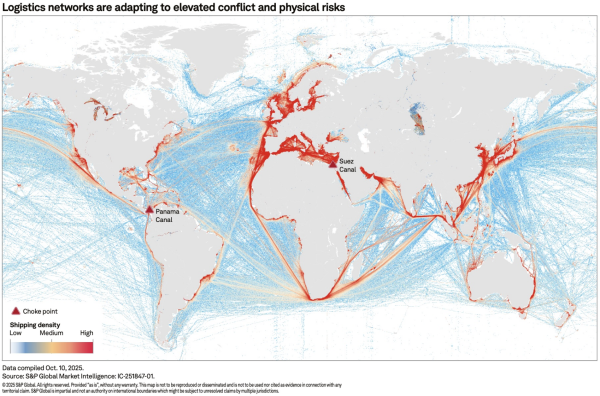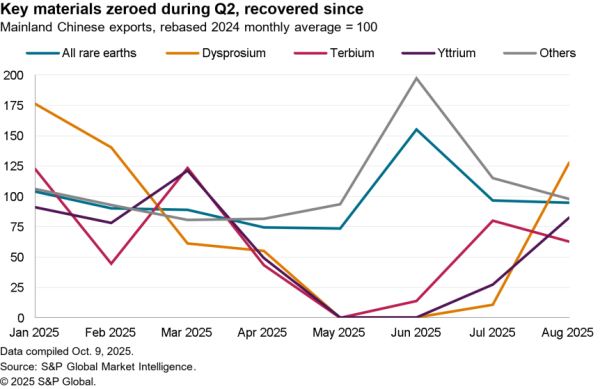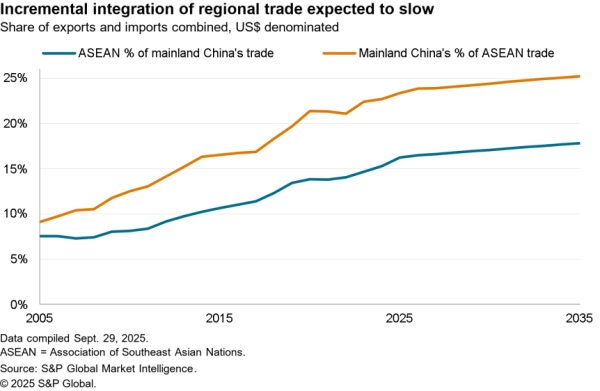Panjiva Research took part in an Atlantic Council event on March 31 titled “Trade disrupted: Global shipping and the future of international commerce“. This report summarizes some of the questions asked augmented with additional data. A full replay is available from the Atlantic Council here.
Q: The blockage of the Suez Canal is a reminder of the interconnectedness of global trade and the challenges logistics operators can face. Which markets have been most affected by the blockage of the Suez Canal?
There have been four broad groups of shipping that have been held up by a week or more. Shipping of most industrial and consumer goods from across Asia to Europe likely represent the largest group as well as the shipment of oil-related products from the Middle East to Europe and beyond.
On reverse routes shipments of capital goods, including intermediate goods that form a critical part of just-in-time supply chains may also have been delayed. Panjiva’s data shows that $46.6 billion of electrical and automotive components were shipped from Europe to Asia east of the Suez Canal in 2019 by all transport modes.
That was led by automotive components and engines which accounted for 37.5% and 8.7% of the total respectively. Other major lines included electrical switches and cables equivalent to 12.4% and 6.9% respectively. China accounted for 49.9% of total shipments.
Shipments from South Asia to the U.S. east coast will also have been affected, as discussed in Panjiva’s March 29 research. There will also be ongoing knock-on effects to downstream supply chains global according to Maersk, which most recently has stated that “shipments not directly impacted by the Suez blockage might also be affected“.

Source: Panjiva
Q: Have shipping vessels gotten too big for the infrastructure that supports them, can anything be done about that?
While a smaller vessel than the Ever Given may not have grounded in the Suez Canal in the way it did, a full investigation will be needed to determine the future of ultra-large container vessels using the route. The spate of container losses on Transpacific routes in Q1’21 has also mostly featured very large or ultra large vessels though there may be a news-selection bias involved.
What can be seen, however, is that the congestion at the ports of LA and Long Beach has come as the proportion of the largest vessels calling at the ports has increased. The port of Long Beach saw the highest rate of delivery by VLCS in the U.S. with 62.2% of volumes in the first two months of 2021 after a 46.4% share in 2020. The national average reached 39.2% in the first two months of 2021 from 23.1% in 2020.
Q: Can digitization help the plight of sailors trapped at sea during the pandemic? What parts of the logistics sector can it help?
The challenge for sailors during the pandemic has come from governments not allowing them to transfer from ports to airports and home, not because of a lack of organization that digitization can solve. A shift in policy for future pandemics or similar risk events is needed.
Digitization can help better organize logistics and provide visibility throughout supply chains, particularly when combined with Internet of Things devices. Port automation, incorporating both hardware and software elements, can also make supply chains more efficient.
Implementation is complex, however, as shown by the port operating system upgrade installed by Felixstowe in 2018. Extensive delays caused by the implementation may have contributed to container lines Maersk and CMA CGM shifting their routings away from the port.
Panjiva’s analysis of official figures shows total handling through the port fell by 8.1% in 2019 compared to 2017. There’s been little sign of a recovery since, in part due to the pandemic, though in Q4’20 shipments inbound to Felixstowe increased by 3.1% year over year as a result of stockpiling ahead of the shift to new trading relations with the EU. Outbound shipments continued to decline with a 6.7% slide over the same period.

Source: Panjiva
Q: Should governments be supporting finance in the logistics industry?
There’s a good case for government support for long-term infrastructure investments where market measures are politically undesirable. The Biden administration’s recently launched infrastructure proposals include $237 billion of investment for road, rail, airport and seaport expansion and renewal, with private implementation and coinvestment likely.
Private investment is arguably better for shorter-lived assets including container and other shipping vessels. Indeed, the recent boom in demand and elevated shipping rates, in part reflecting improved capacity discipline from the liners has led to a swathe of new vessel orders. There is still a risk of market distortions from government actions though, particularly given regulatory risks regarding shipping rates and state “encouragement” for national flag carriers to prioritize their home markets’ exports.
Q: Will the blockage of the Suez Canal support the use of alternative land routes including rail?
Yes. There has been a trend that way already with the ocean liners offering integrated rail-and-sea transportation from Asia to Europe since as early as 2018. Cargo owners and freight forwarders should also be considering diversified routing options for switching at short notice.
Q: Is reshoring a good idea, will it reduce the risks illustrated by the Suez Canal blockage?
Supply chain decision makers constantly balance the cost and risk characteristics of their operations. Reshoring is more often a government-driven initiative motivated by employment needs than supply chain optimization. The Suez Canal blockage arguably underscore the importance of a diverse rather than simply a local supply chain.
Yet, local production is also no guarantee of risk reduction. The winter storms in Texas proved as problematic for local plastics manufacturers and users as it did for those on the other side of the world. Similarly, the timing of the closure and reopening of manufacturing during the pandemic between the U.S. and Mexico led to significant disruptions of automotive supply chains even though supplier and buyer were only a few hours drive apart from each other.
Panjiva’s data shows Mexican exports of automotive components to the U.S. fell by 87.0% year over year in May before steadily recovering to expand by 18.6% in December. A subsequent drop of 9.6% in January and 2.4% in February may reflect challenges caused by a shortage of semiconductors. The latter is more a matter of industry purchasing practices under the just-in-time approach rather than the location of sourcing.

Source: Panjiva




